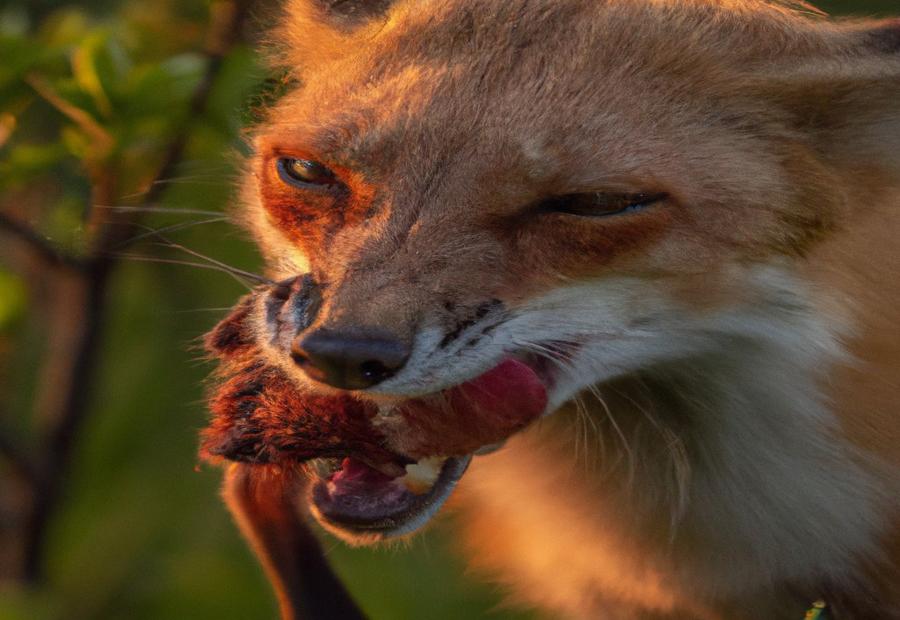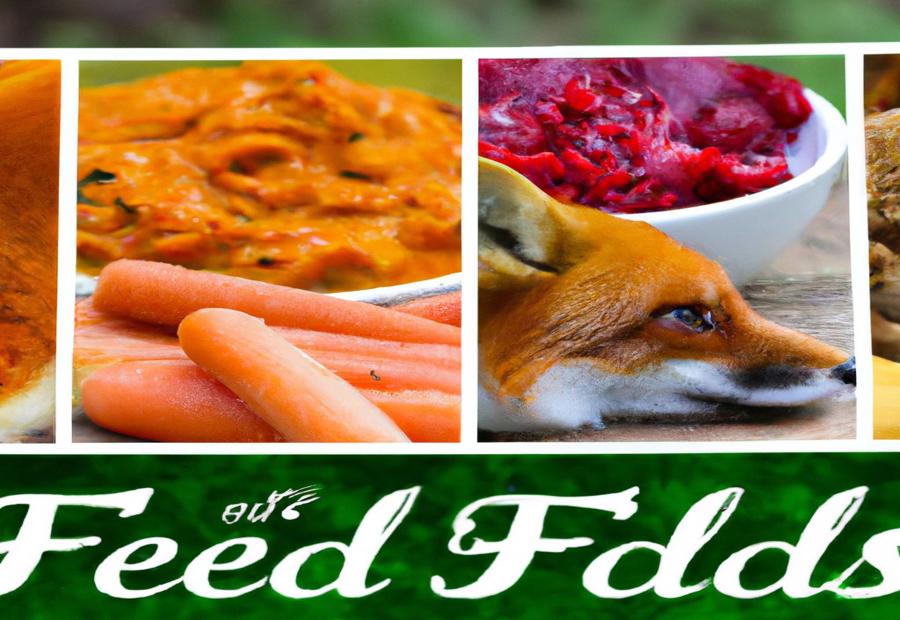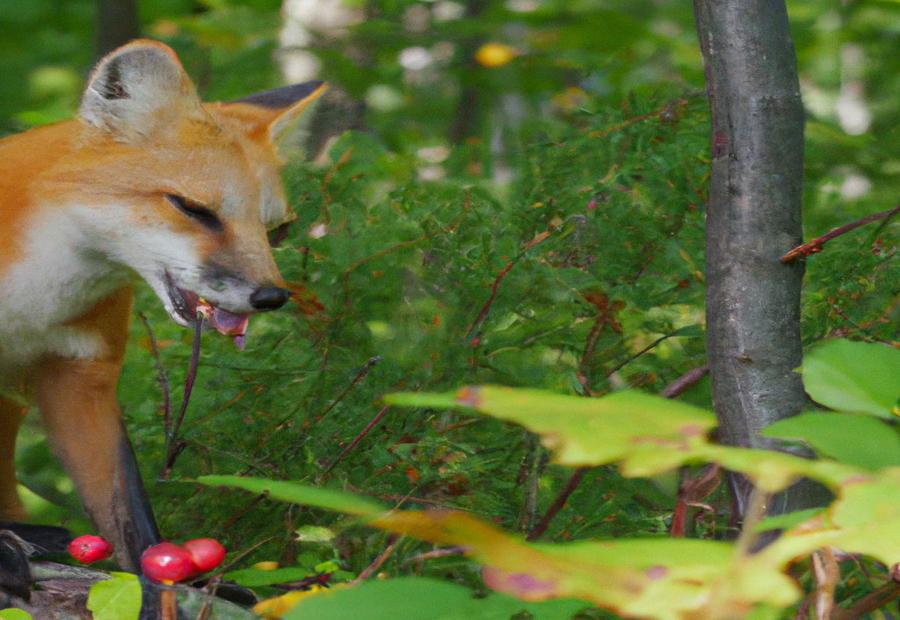Red foxes, known for their striking red fur and cunning nature, are fascinating creatures that inhabit various regions across the world. Understanding their dietary habits is essential in gaining insight into their behavior and survival strategies. Research conducted by wildlife biologist John A. Byers sheds light on the fascinating role of red fox in human interaction: understanding their behavior and impact.
Red foxes have a diverse diet that can vary based on their available food sources and environmental conditions. While they are primarily carnivorous, their diet can also include a variety of other food items. In the wild, red foxes primarily hunt and consume small mammals, such as mice, voles, rabbits, and squirrels. They are also skilled hunters of birds and their eggs, insects, and invertebrates found in their habitat. red foxes exhibit omnivorous tendencies and may consume fruits, berries, and even plant matter when available.
Red foxes are known for their opportunistic hunting behavior, adapting their diet to the food sources available in their surroundings. They employ clever techniques like stalking, pouncing, and digging to capture their prey. Their excellent hearing and keen sense of smell enable them to locate their targets accurately.
The amount of food red foxes consume can vary depending on factors such as the availability of prey, season, and reproductive status. On average, an adult red fox may require approximately 1 to 2 pounds of food per day to meet its energy needs.
Human activities and urbanization can have an impact on the diet of red foxes. They may be attracted to human-provided food sources, such as garbage bins or leftovers, in urban areas. This can lead to changes in their natural diet and potentially affect their overall health and behavior.
Understanding what red foxes like to eat is crucial to appreciate their role in the ecosystem and to ensure their conservation. By preserving their natural habitat and avoiding feeding them human-provided food, we can help maintain the delicate balance of their diet and contribute to their well-being in the wild.Exploring the Traits and Habits of Red Fox Dens
Contents
- 1 Dietary Habits of Red Foxes
- 2 What do Red Foxes Eat in the Wild?
- 3 Are Red Foxes Carnivores?
- 4 Do Red Foxes Scavenge for Food?
- 5 Main Food Sources for Red Foxes
- 6 Red Foxes as Opportunistic Hunters
- 7 How Much Do Red Foxes Eat?
- 8 Impact of Human Activities on Red Foxes’ Diet
- 9 Human-Provided Food Sources for Red Foxes
- 10 Effects of Urbanization on Red Fox Diet
- 11 Impact of Wetland Habitats on Red Fox Diet
- 12 Identification Difficulties with Red Fox Diet
- 13 Red Foxes in Rural and Urban Environments
- 14 Comparison with Gray Foxes
- 15 Frequently Asked Questions
Dietary Habits of Red Foxes
The dietary habits of red foxes, also known as Vulpes vulpes, are incredibly diverse and adaptable, allowing them to thrive in various environments across the globe. The consumption patterns of red foxes play a vital role in their survival and overall well-being.
When it comes to their common food sources, red foxes exhibit remarkable hunting skills. They primarily prey on small mammals, such as mice, voles, and rabbits, which contribute significantly to their diet. Additionally, red foxes display opportunistic behavior and seize the chance to consume birds, including ground-nesting species and vulnerable chicks.
Insects also serve as a supplementary food source for red foxes, especially during the warmer months. Beetles, grasshoppers, and crickets become a delectable treat for these cunning creatures. Although not a major part of their diet, red foxes occasionally snack on fruits and berries, such as apples, blackberries, and raspberries.
Furthermore, red foxes display scavenging tendencies and are known to indulge in carrion. They eagerly devour the remains of larger animals, such as deer or livestock. In their quest for sustenance, red foxes frequently raid nests, feasting upon eggs, especially those belonging to ground-nesting birds or reptiles.
It is essential to note that the specific diet of red foxes can vary depending on their geographical region and the availability of food. These incredible hunters possess a high level of adaptability, allowing them to adjust their dietary preferences according to the season and food availability.
Understanding the dietary habits of red foxes holds immense importance in wildlife conservation efforts. By comprehending their eating patterns, we can contribute to maintaining the delicate balance of ecosystems they inhabit and ensure the continued survival of these remarkable creatures.
What do Red Foxes Eat in the Wild?

Photo Credits: Foxauthority.Com by Raymond Roberts
Red foxes in the wild have a varied diet, feeding primarily on small mammals such as voles, mice, and rabbits. These mammals provide important nutrients and energy for the foxes to survive and thrive. In addition, red foxes also eat birds, eggs, insects, and fruits. They are skilled hunters, capable of catching birds in mid-air. Red foxes are also scavengers, consuming carrion and leftovers from larger predators. Their diet can adapt depending on the availability of food sources. For example, if small mammals are scarce, they may rely more on fruits and insects. Red foxes are known for their agility, being able to jump over 6 feet high and 15 feet in length. This agility helps them catch prey and escape predators effectively.
What do Red Foxes Eat in the Wild?
Are Red Foxes Carnivores?
Yes, red foxes are indeed carnivores. They have a diverse diet consisting of various animal species, which they consume as a part of their natural feeding habits. Red foxes commonly hunt and prey on small mammals like mice, voles, rabbits, and squirrels. These small mammals make up a significant portion of their overall diet. Furthermore, red foxes also have the ability to catch and eat birds and their eggs both on the ground and in the air. They demonstrate their hunting skills in raiding bird nests to obtain eggs as well.
Although not their primary food source, red foxes will consume insects and invertebrates such as beetles, worms, and other insects that inhabit their environment. Additionally, they have been observed consuming reptiles like snakes and lizards, as well as amphibians like frogs and toads. The consumption of these prey items is more likely to occur during particular seasons or when other food sources are scarce. Occasionally, red foxes may even include plant matter in their diet, such as fruits, berries, and grasses. However, it is important to note that this only comprises a very small percentage of their overall nutritional intake.
It is worth noting that red foxes are known for their opportunistic feeding behaviors and their ability to adapt their diet according to the food sources available in their environment. They possess exceptional hunting skills and display a wide range of prey items that they can successfully feed on. So, in summary, red foxes are indeed carnivores, but their diet is flexible and varies depending on the circumstances.
Do Red Foxes Scavenge for Food?
Red foxes do scavenge for food. They actively search for and consume a wide variety of sources to meet their dietary needs. Here are some facts about red foxes scavenging for food:
- Red foxes primarily hunt small mammals like rabbits, rodents, and squirrels. They use their acute hearing and sharp eyesight to locate prey and pounce on it.
- In addition to hunting, red foxes scavenge by consuming the carcasses of larger animals, such as deer or birds. They are attracted to carrion and will feed on it when available.
- Red foxes also scavenge from human sources. They may search for discarded food in trash cans or scavenge from agricultural areas where leftovers or crops are available.
- While red foxes are skilled hunters and scavengers, they also have a diverse diet. They consume insects, fruits, berries, and reptiles as needed.
- The scavenging behavior of red foxes is influenced by factors such as food availability and competition. When prey is scarce, they rely more on scavenging to fulfill their nutritional needs.
It is important to note that red foxes can adapt to different environments and adjust their feeding strategies accordingly. Their ability to scavenge for food ensures their survival in various habitats and helps maintain a balanced ecosystem.
Main Food Sources for Red Foxes
The main food sources for red foxes are small mammals, birds, insects, fruits and berries, and carrion.
Red foxes primarily feed on small mammals such as voles, mice, and rabbits. They have excellent hunting skills to catch these fast-moving prey.
Red foxes are opportunistic predators and will consume birds when the opportunity arises, especially smaller ground-nesting birds.
Insects, like beetles and grasshoppers, are part of the red foxes‘ diet, especially during the summer months when they are more abundant.
They can also supplement their diet with fruits and berries, particularly in autumn when these food sources are plentiful.
Red foxes are scavengers and will feed on carrion, including roadkill or other deceased animals they come across.
Pro-tip: Supporting habitats that have populations of small mammals and birds can attract red foxes to your area.
Red Foxes as Opportunistic Hunters
Red foxes, known as opportunistic hunters, possess remarkable skills that enable them to adapt to diverse food sources. They specialize in targeting small mammals such as voles, mice, rabbits, and squirrels. In addition to these, red foxes also consume birds, reptiles, and amphibians whenever possible. Their flexible eating habits allow them to scavenge on carrion, insects, and even fruits when needed. Their hunting abilities extend to both land and water, where they excel at capturing fish and aquatic invertebrates.
One of the key strengths of red foxes is their ability to exploit their surroundings to find food. With their acute senses, they can locate their prey through sound or movement. These resourceful hunters adjust their strategies according to the diverse landscapes and weather conditions they encounter, ensuring they make the most of the prey available. Red foxes employ stealth and agility to approach their unsuspecting victims silently, giving them the element of surprise.
Although red foxes do not have a specific diet, they possess the adaptability to thrive in various habitats, such as forests, grasslands, and even urban areas. Their opportunistic nature allows them to flourish by taking advantage of the resources found in their environment.
A fascinating fact about red foxes lies in their exceptional hearing, thanks to their large, pointed ears. They possess the ability to hear the faintest sounds, like a mouse rustling in the grass, even from a distance of over 100 feet away!
How Much Do Red Foxes Eat?
Red foxes eat a diverse diet that depends on food availability and seasonality. They consume approximately 0.5 to 1.5 kilograms (1 to 3 pounds) of food per day. So, the question arises, “How much do red foxes eat?” Their diet includes small mammals, birds, insects, fruits, and vegetables. Small mammals, such as voles, mice, rabbits, and squirrels, make up a significant portion of their food intake. They are skilled hunters and can also catch birds, reptiles, amphibians, and insects. Red foxes scavenga on carrion and eat fruits, berries, and other vegetation when available. The amount of food they eat may vary depending on age, sex, and reproductive status. During times of food scarcity, red foxes reduce their food intake to survive. Red foxes are adaptable and can survive on various food sources. Providing suitable habitats with ample prey availability and avoiding accessible human food or garbage can help support their populations and maintain their natural foraging behaviors.
Impact of Human Activities on Red Foxes’ Diet
Human activities significantly impact the diet of red foxes by altering the availability and accessibility of food sources, which in turn affects their nutritional balance. Several key factors must be considered:
1. Urbanization: The expansion of human settlements diminishes natural habitats, leading to a decrease in prey availability for red foxes. In response, they adapt to urban environments by scavenging for food from garbage bins or preying on small mammals like rodents.
2. Agriculture: Changes in land use for agriculture can also impact red foxes’ natural food sources. In areas dominated by crop fields, red foxes may have limited access to prey, compelling them to rely on alternative sources such as insects, fruits, or carrion.
3. Hunting and Pest Control: Human activities such as hunting and pest control directly affect the populations of small mammals that red foxes depend on for food. When small mammal numbers are reduced, foxes have to travel far from their den to find food. When small mammal numbers are reduced, food scarcity ensues, forcing foxes to search for alternative options.
4. Habitat Destruction: Deforestation and habitat destruction result in the loss of suitable grounds for red foxes to forage and nest. This disruption in their food chain greatly impacts them as they rely on a diverse range of prey for a balanced diet.
Human activities play a crucial role in shaping the diet and survival of red foxes. It is imperative to consider the ecological implications of our actions and strive for sustainable practices that preserve wildlife habitats and support natural food sources.
In a small town heavily reliant on agriculture, the expansion of crop fields had a drastic impact on the red fox population. As their natural prey became scarce, the foxes had no choice but to scavenge near human settlements. This led to conflicts with residents who were concerned about property damage and the safety of their domestic animals. To address this, efforts were made to create wildlife corridors and implement sustainable farming practices that would protect the habitats of predators like the red fox, while also ensuring community safety and livelihoods. Through these initiatives, the red fox population gradually regained access to their natural prey, and tensions between humans and wildlife diminished. This story serves as a reminder of the importance of balancing human activities with the preservation of wildlife habitats.
Human-Provided Food Sources for Red Foxes

Photo Credits: Foxauthority.Com by Nathan Brown
Red foxes, like other wildlife species, have learned to rely on a variety of food sources provided by humans. These food sources include small mammals, such as mice and voles, which make up a significant portion of their diet. In addition, red foxes occasionally consume fruits like berries to supplement their nutrient intake and add variety to their diet. They are also known to scavenge for human leftovers, such as discarded food or from garbage bins, when they are available.
However, it is important to understand that while human-provided food sources can benefit red foxes, their natural diet primarily consists of small mammals. Therefore, it is not advisable to rely solely on human leftovers as the main food source for red foxes. Furthermore, when offering food to red foxes, it is crucial to consider the potential negative effects it may have on their timing and behavior when coming out of their dens.
By gaining a better understanding of the different food sources used by red foxes and their significance, we can develop a better appreciation for their dietary preferences and make well-informed decisions when encountering these fascinating creatures in human environments.
Effects of Urbanization on Red Fox Diet
Urbanization has a significant impact on the diet of red foxes. The effects can be seen in several ways. Firstly, the expansion of urban areas reduces natural habitats, replacing them with buildings and infrastructure. This, in turn, restricts the availability of natural prey for red foxes, such as rabbits, rodents, and small mammals. Consequently, foxes may adapt their diet to include alternative food sources.
Secondly, urbanization brings about an abundance of human-related food sources, including garbage bins and compost heaps. Red foxes, being opportunistic feeders, may scavenge discarded food such as leftovers and food waste. This change in diet can have both positive and negative effects on the fox population.
Moreover, urban areas tend to have a higher concentration of domestic pets, presenting a potential food source for red foxes. They may prey on small dogs and cats or consume pet food left outside. However, this shift in diet can also lead to conflicts between foxes and pet owners.
Furthermore, the urban landscape differs from natural habitats, causing changes in feeding behavior for foxes. In order to adapt to the urban environment, they may become more nocturnal to avoid human activity. Additionally, they may learn to forage in gardens and urban green spaces for fruits, vegetables, and insects.
Lastly, the effects of urbanization on red fox diet can ultimately impact their population dynamics. A limited availability of natural prey, coupled with an increased reliance on human-related food sources, can lead to changes in fox population density, distribution, and behavior. Overall, urbanization significantly influences the diet and ultimately the survival of red foxes.
Impact of Wetland Habitats on Red Fox Diet
Wetland habitats play a crucial role in influencing the diet of red foxes. These habitats offer an array of diverse and plentiful food sources that are essential for these carnivorous animals. Within wetlands, there is a wide variety of prey species including small mammals, birds, reptiles, and amphibians, all of which are necessary for sustaining the population of red foxes.
The existence of wetland habitats considerably enhances the feeding opportunities for red foxes and ensures a consistent supply of food. Marshy areas specifically support a higher concentration of small mammals such as voles and mice, which serve as a primary food source for red foxes. Furthermore, wetlands attract waterfowl, which significantly contribute to the diet of these foxes. Studies have demonstrated that in certain wetland habitats, waterfowl can make up as much as 30% to 50% of the food consumed by red foxes.
Moreover, wetland habitats also serve as breeding grounds for insects and aquatic invertebrates. These small organisms play a crucial role as food sources for red foxes, particularly during the breeding season when the foxes need to provide for their growing offspring. The abundance of insects and invertebrates within wetlands greatly contributes to the overall nutrition and survival of the red fox population.
Identification Difficulties with Red Fox Diet

Photo Credits: Foxauthority.Com by Steven Hall
Identification difficulties with the Red Fox Diet can arise due to their adaptable and opportunistic nature in finding food.
The Red Fox primarily feeds on small rodents, such as mice and voles, as well as rabbits, squirrels, birds, and amphibians.
They have a diverse diet and show little preference for a specific type of prey.
Specific dietary patterns are challenging to identify due to the wide range of potential food sources that arctic foxes exploit.
Observational evidence and studies on their feeding behavior can provide factual information about grey fox diet.
Red foxes scavenge on carrion and may also consume human waste and trash in urban areas.
This adaptability makes it difficult to determine their diet.
The composition of a red fox’s diet varies based on factors such as geographic location, season, and prey abundance.
Therefore, precise numerical details on the proportion of each prey item in their diet are challenging to provide.
To accurately determine the diet of red foxes, researchers utilize methods like scat analysis and direct observation to identify prey remains in their scat or document hunting behaviors.
Red Foxes in Rural and Urban Environments
Red foxes are highly adaptable animals that can be found in both rural and urban environments.
In rural areas, these clever creatures primarily rely on small mammals such as mice, voles, rabbits, and squirrels as their main source of sustenance. Using their keen hearing and acute sense of smell, they skillfully locate their prey and swiftly capture them with their agility and speed.
However, in urban environments, red foxes have adapted their diet to include a wider variety of food sources. They take advantage of human settlements and the associated food opportunities, which include scavenging for garbage, raiding bird feeders, and occasionally hunting unsupervised small pets like rabbits or cats.
Red foxes are opportunistic eaters who are capable of adapting to the available resources in their surroundings. They are known to consume fruits, vegetables, insects, and carrion. In urban areas where natural prey is scarce, red foxes significantly rely on human waste as a substantial part of their diet.
It is crucial to recognize that red foxes are protected species in numerous areas. It is strictly advised not to deliberately provide them with food or encourage dependency on humans as a food source. Feeding them disrupts their natural behavior and may result in conflicts with humans.
Comparison with Gray Foxes

Photo Credits: Foxauthority.Com by Gabriel Robinson
Comparison with Gray Foxes
Physical Appearance
Red Foxes have reddish-orange fur with white-tipped tails, while Gray Foxes have gray fur with a black-tipped tail.
Habitat
Red Foxes prefer forests, grasslands, and urban areas, while Gray Foxes are commonly found in wooded areas and brushy habitats.
Behavior
Red Foxes are more adaptable and opportunistic in their feeding habits compared to Gray Foxes, who specialize and heavily rely on small mammals.
Diet
Red Foxes have a varied diet including small mammals, birds, insects, and fruits, while Gray Foxes primarily feed on small mammals like rabbits and rodents.
Reproduction
Both Red and Gray Foxes mate in winter. Red Foxes have a gestation period of around 52 days, while Gray Foxes have a longer gestation period of approximately 63 days.
Frequently Asked Questions
What do red foxes like to eat?
Red foxes have a diverse diet consisting mainly of small mammals such as rodents (such as rats, mice, voles, and squirrels) and lagomorphs (such as rabbits and hares). They also consume birds, amphibians, insects, reptiles, fish, berries, and fruits. They are opportunistic predators and will adapt their diet to their environment.
Do red foxes eat fox cubs?
No, red foxes do not typically eat their own cubs. They are protective of their offspring and provide care and food for the young ones until they are old enough to hunt and feed themselves.
What are the favorite foods of red foxes?
Red foxes have a variety of favorite foods, including small mammals like field voles, bank voles, wood mice, grey squirrels, and deer mice. They also enjoy fruits such as cherries, persimmons, mulberries, grapes, plums, apples, and raspberries. Additionally, they have a preference for insects like crickets, grasshoppers, beetles, and hoverfly larvae.
Can red foxes eat canned dog food?
Yes, red foxes can eat canned dog food. If kept as pets or in captivity, canned dog food can provide them with the necessary nutrients. However, in the wild, their diet primarily consists of natural prey and scavenged food.
Do red foxes eat rotting carcass flesh?
Yes, red foxes are known to scavenge for food, including consuming rotting carcass flesh. They have a keen sense of smell and can detect and feed on carrion from various sources.
What is the worming behavior of red foxes?
Red foxes have been observed hunting for earthworms and have a behavior known as worming. They use their keen sense of hearing and smell to locate and dig for earthworms in gardens or other suitable habitats. This behavior is more common in dominant foxes that monopolize resources.